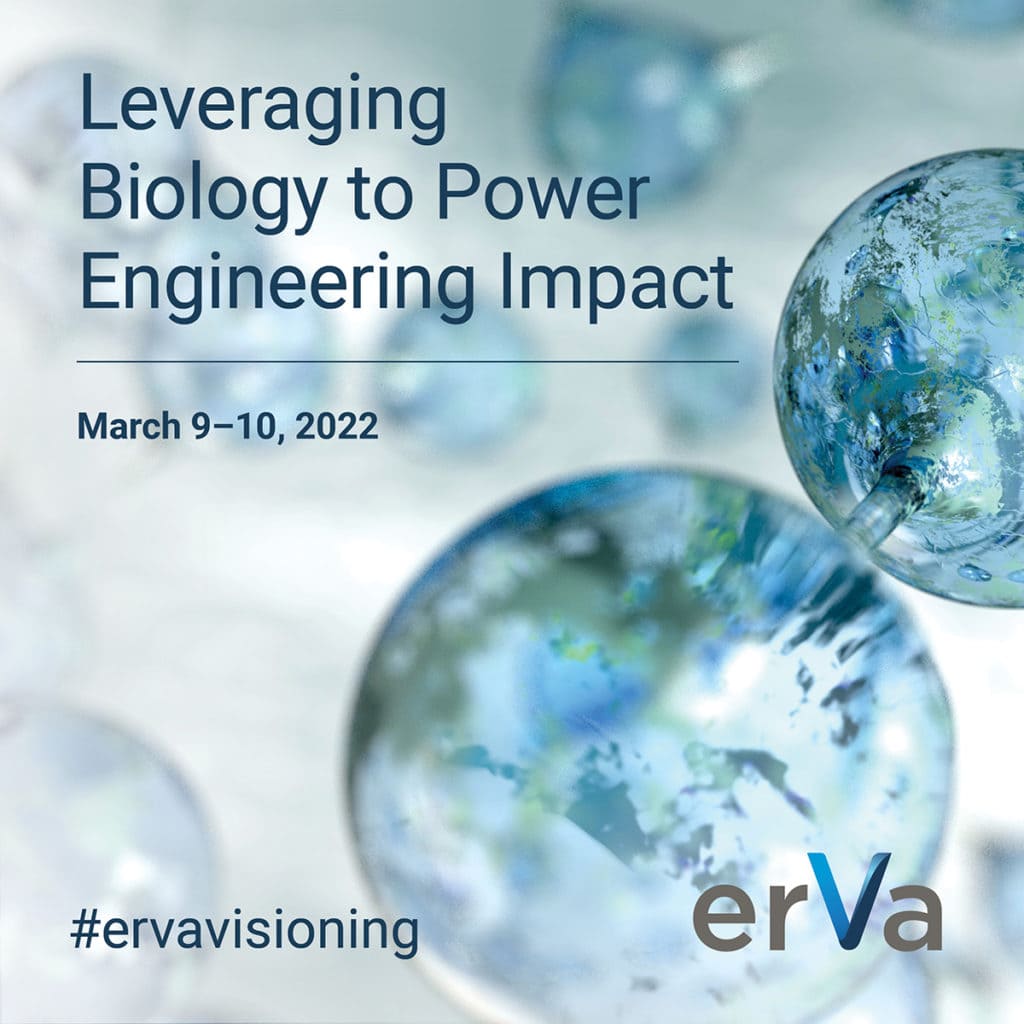03•09•2022 @ 11:00 am - 03•10•2022 @ 5:00 pm
View the archived event page, agenda, and meet the speakers.
ERVA is charged with the strategic convening of interdisciplinary groups of experts to collaboratively identify bold and transformative new engineering research directions. ERVA visioning events provide unique opportunities for selected participants to advance our goal of catalyzing the pursuit of innovative, high-impact research that benefits society.
Our second visioning event explored the topic of Leveraging Biology to Power Engineering Impact. The interface of biology and engineering continues to provide incredibly rich opportunities for impact as well as mutual advancement for both fields.

Workshop attendance was carefully curated. Participants were identified and invited based on their research and expertise, taking into account ERVA’s identity as a diverse, inclusive, and engaged partnership that enables an array of voices to impact national research priorities. Such considerations include an overall participant list diverse by dimensions including but not limited to: research discipline; geographic location; organization sector and type; gender; race/ethnicity; and career stage.
The report that results from this event will include high-value findings that identify less-explored lines of research ripe for engineering community pursuit with potential for the greatest return on investment.
Eleni Stavrinidou, Linköping University, Associate Professor and Principal Investigator at Electronic Plants
David Kong, MIT Media Lab, Synthetic Biologist
Sarah Richardson, MicroByre, CEO
Visioning Event Summary
The interface of biology and engineering continues to provide incredibly rich opportunities for impact as well as mutual advancement for both fields. The application of engineering principles of design and analysis to biological systems and biomedical technologies has yielded important advances for healthcare and medicine, manufacturing, agriculture, and other application areas. The field of Bioreplacements, for example, illustrates how understanding biology can be used to inform the design of engineered components that can then be used to replace or improve biological systems. Human quality of life may be improved through the restoration of sensory, motor, or cognitive functions using engineered devices or systems. Increasing interest focuses on the development of wearable devices that not only monitor but also modulate human biology for enhanced health.
However, the natural world provides many sources of inspiration for engineering novel systems beyond those used to restore or augment human function. Here we group some of these approaches under the heading: Leveraging Biology to Power Engineering Impact.
Three general approaches through which engineering can achieve impact via leveraging knowledge and understanding of natural biological systems are identified as being of interest:
- Bio-inspired / Bio-informed
Inspiration from biology is used to engineer components and systems. Naturally occurring chemistry from both animals and plants has driven advances in materials science. Design of engineered systems has been informed by nature-based mechanical solutions. Neuroscience is under scrutiny to provide inspiration for brain-based data storage and computational capabilities. In the future, we stand to learn much from biological mechanisms of resilience and adaptation to inform the design of engineering structures and systems. - Repurposing Biology
Biological constructs may be adopted and adapted for purposes beyond their existing biological function. A classic example of this is the use of DNA molecules for data storage, building on the remarkable integrity and potential for error-free replication of this macromolecule. Additionally, intense interest is focused on designer organisms, products of synthetic biology, that may afford functionalities from mining, to agriculture, to bio-foundries. Engineered living systems may provide building blocks for next-generation sustainable engineering. - Improving on Biology
It’s also possible to envisage engineering components and systems that go “beyond biology." One potential example is manipulating the interactions between species in different kingdoms. This “interkingdom engineering” has breathtaking potential to improve human health, for example by manipulating the human microbiome to ameliorate obesity or interrupting interspecies virus transfer to diminish disease spread.
Each of these areas offers exciting potential for genuine engineering advances, leveraging biology to power engineering impact. To maximize the potential will require deliberate articulation of parameters and constraints at this intersection of biology and engineering.